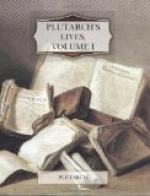Romulus, in order to make the fulfilment of his vow as pleasing to Jupiter, and as fine a spectacle for the citizens as he could, cut down a tall oak-tree at his camp, and fashioned it into a trophy,[A] upon which he hung or fastened all the arms of Acron, each in its proper place. Then he girded on his own clothes, placed a crown of laurel upon his long hair, and, placing the trophy upright on his right shoulder, marched along in his armour, singing a paean of victory, with all the army following him. At Rome the citizens received him with admiration and delight; and this procession was the origin of all the subsequent triumphs and the model which they imitated. The trophy itself was called an offering to Jupiter Feretrius; for the Romans call to strike, ferire, and Romulus prayed that he might strike down his enemy. The spoils were called spolia opima, according to Varro, because opim means excellence. A more plausible interpretation would be from the deed itself, for work is called in Latin opus. This dedication of spolia opima is reserved as a privilege for a general who has slain the opposing general with his own hand. It has only been enjoyed by three Roman generals, first by Romulus, who slew Acron, king of the Ceninetes, second by Cornelius Cossus, who slew the Tyrrhenian Tolumnius, and, above all, by Claudius Marcellus, who killed Britomart, the king of the Gauls. Now Cossus and Marcellus drove into the city in chariots and four, carrying the trophies in their own hands; but Dionysius is in error when he says that Romulus used a chariot and four, for the historians tell us that Tarquinius, the son of Demaratus, was the first of the kings who introduced this pomp into his triumphs. Others say that Poplicola was the first to triumph in a chariot. However, the statues of Romulus bearing the trophy, which are to be seen in Rome, are all on foot.




